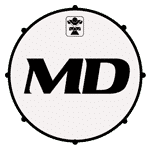Chris Guglielmo of Bayside

Talking Smoothness, Timing, and Recording
What’s up Modern Drummer! My name is Chris Guglielmo and I play drums in a band called Bayside. From the beginning my approach was always more methodical than structured. My preferred curriculum was to listen to music that excited me and then figure out how to play it. My listen and learn time was usually during class with headphones on under my hood.
I started off playing in high school band and bands with friends and then began doing studio work around the age of seventeen. Both my high school band teacher and a friend who owned the studio I worked at really believed in me. They pushed me to try new things and taught me how to be comfortable when placed out of my comfort zone. When we are uncomfortable as players it usually means we are engaging in something we are not used to. It is important to recognize when this happens and embrace it, as these are the times to learn and grow. If you find yourself in this position, don’t walk away from it. Instead, push yourself to move through it in the best way you know how and understand you are evolving as a player. Be ok with making mistakes and nothing will stand in your way. My music teacher and studio friend really helped me plant these strong roots into the ground of what was going to support and carry me throughout my professional career.
While working in the studio I had a crash course in the concept of keeping time. I always had the natural ability to keep time, for which I am very grateful. All throughout high school I led the marching band up and down Wantagh Avenue for miles with that good old 1 and 3 on the snare, but moving around that time was a different story. Understanding how to push and pull time was the new game. Learning how to manipulate time by using drum fills, different kick and snare patterns, accelerating or decelerating hi-hat patterns, playing behind or on top of the beat—these are the things I learned in the studio. Advertisement
As I progressed with my timing, I started to realize that drums were all about balance and fluidity. Literally keeping yourself physically balanced while playing came into the picture. Keeping time on the left foot and ghost notes on the left hand started yielding very interesting results. I felt less on top of my kit and more of an extension of it. My velocities started to become more consistent; there was now balance and fluidity.
I started to think about how my body was moving when I would play. I would always say to myself, “what are my hands and feet doing when I’m NOT striking a drum or cymbal. Where are my hands and feet in proximity to my drums when they are not being used?” I started to notice that the trajectory of my movements was not in straight lines but more like circles. When I would move through a fill and have to come back around the kit to hit a crash, I started paying attention to how I moved through the fill. How can I move through this as smooth as possible so I end up where I need to be when I want to be there and with enough effortless momentum to continue into the next part of the song? Think about circles when you are playing, be loose, breathe, and move with fluidity. Smoother is faster. You are a machine and efficiency is key!
The first album I recorded with Bayside was called The Walking Wounded. I was twenty years old when I joined the band. As we recorded more and more I noticed myself backing off on writing my parts. I would go into the studio with notes for every song and drum fills written out and listen back to our discography. I never really felt like that process gave me the best results. Over the next fourteen years I dialed back my pen and paper calculations and switched my thought process over to specific intentions. My intentions were to play off of feel and feel only. I wanted to have a completely clear mind when it was time to track drums and I knew I had to completely disconnect myself from the songs. When we finished pre production for our current release “Interrobang,” I didn’t touch drums or listen to the songs at all. Advertisement
Our producer Cameron Webb called one day and said he wanted me to rehearse the songs a few days out from recording to get familiar with them. I told him “no thank you,” and that I was not going to rehearse. He was not too excited about my answer but I told him not to worry. When I showed up to Studio 606 to track drums I was nervous and anxious but also excited. I knew I was just second-guessing my intentions so I silenced those thoughts pretty quickly. It was time to dive in headfirst. I walked into the control room and saw the famous Neve console that recorded Nirvana’s Nevermind and a ton of other massive albums. On the console itself was Stevie Nicks’ autograph. That studio is a very special place and it almost feels like it’s alive. We started tracking drums and every song, one after the other, had this new life to it. It was like I was hearing them for the first time. Writing drum fills and parts on the spot doing take after take was a total blitzkrieg! It was fresh and exciting. We were moving fast and we were working efficiently. There were no hang-ups or stutters. The session was the smoothest and most creative I had ever personally experienced. Cameron pushed me outside of my comfort zone on things I thought I had truly understood.
I learned a few things during this session. You don’t need to overwork writing. Sometimes you need to step away and let things breathe a little. Also, Cameron spoke a language I didn’t really understand at first and it took a conscious effort to decode his drum language. It was uncomfortable and different at first but I knew in that moment what we were doing was going to be special. Thanks for reading and I’ll see you on the road!
Check out the “Interrobang” video here
For more on Bayside, visit www.baysidebayside.com and www.facebook.com/Bayside.


